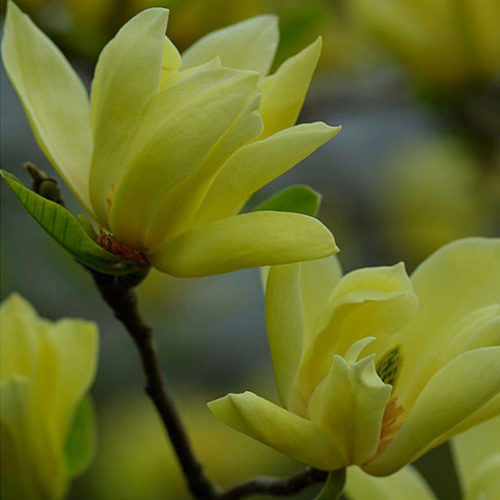
This cross of Magnolia acuminata and M. denudata usually forms a small tree with an upright central leader or sometimes a multistemmed shrub. It has yellow cup to star-shaped flowers (3 to 4 inches across) that are fragrant and appear before the leaves in early to mid-spring.
CareGrow in moist, well-drained, preferably acidic to neutral soil in full sun or partial shade; this plant does not tolerate wet feet. Magnolia flowerbuds are susceptible to late-season frosts; shelter large-leaved species from windy locations. Prune trees and deciduous shrubs in late winter or late summer to prevent bleeding of sap; prune minimally to maintain a healthy framework.
PropagationSow seeds in autumn or stratify to hasten germination. Root softwood cuttings in early summer. Magnolias can be layered in early spring, grafted in winter, and propagated by bud in summer.
ProblemsBacterial leaf spot, spot anthracnose, canker, dieback, butt rot, powdery mildew, anthracnose, fungal spots, weevils, snails, scale insects, thrips, planthoppers
Fine Gardening Recommended Products

Lee Valley Garden Knife
Fine Gardening receives a commission for items purchased through links on this site, including Amazon Associates and other affiliate advertising programs.

Gardener's Supply Company Summerweight Fabric Plant Cover
Fine Gardening receives a commission for items purchased through links on this site, including Amazon Associates and other affiliate advertising programs.

Lee Valley Mini Garden Shear Set
Fine Gardening receives a commission for items purchased through links on this site, including Amazon Associates and other affiliate advertising programs.
- Genus : Magnolia
- Plant Height : 15 to 30 feet
- Plant Width : 15 to 30 feet
- Zones : 5, 6, 7, 8, 9
- Characteristics : Fragrant Flowers, Showy Seed Heads
- Light : Full Sun to Partial Shade
- Maintenance : Low
- Moisture : Medium Moisture
- Growth Rate : Moderate
- Bloom Time : Spring
- Plant Seasonal Interest : Spring Interest
- Plant Type : Trees
- Flower Color : Yellow
Plant Characteristics are only available to Fine Gardening members
Sign up for a free trial and get instant access to our complete plant guide as well as our entire collection of articles and videos.




























